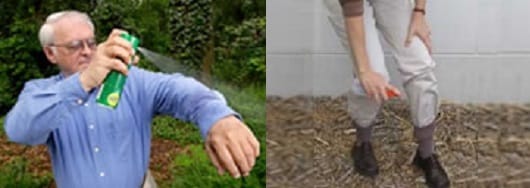Tick-Borne Diseases: Recommendations

Recommendations for Employers
Employers should protect their workers from tick-borne diseases by taking these steps:
- Provide training for workers that includes information about the following:
- How tick-borne diseases are spread
- The risks of exposure and infection
- How workers can protect themselves from ticks
- The importance of the timely reporting of workplace illnesses and injuries
- Recommend that workers wear light-colored long-sleeved shirts, long pants, socks, and hat when possible.
- If worker uniforms are provided, provide long-sleeved shirts and long pants as options.
- Provide workers with Environmental Protection Agency (EPA)-registered insect repellents containing DEET, picaridin, IR3535, Oil of Lemon Eucalyptus (OLE), para-menthane-diol (PMD), or 2-undecanone.
- Provide workers with repellents (such as Permethrin) to provide greater protection. Permethrin kills ticks on contact. It can be used on clothing but not skin.
- When possible, have workers avoid working at sites with woods, bushes, tall grass, and leaf litter.
- When avoiding these sites is not possible, personal protective measures are of particular importance. If work in these higher-risk sites must occur, take the following steps to reduce tick populations:
- Remove leaf litter.
- Remove, mow, or cut back tall grass and brush.
- Discourage deer activity.
Recommendations for Workers
Take the following steps to protect yourself from tick bites:
- Wear a hat and light-colored clothing, including long-sleeved shirts and long pants tucked into boots or socks.
- Use Environmental Protection Agency (EPA)-registered insect repellents containing DEET, picaridin, IR3535, Oil of Lemon Eucalyptus (OLE), para-menthane-diol (PMD), or 2-undecanone.
- EPA’s search tool can help you find the product that best suits your needs.
- Always follow product instructions.
- Treat clothing and gear with products containing 0.5% permethrin.
- Permethrin kills ticks on contact.
- Permethrin can be used to treat shoes, clothing, and gear but should not be used on skin.
- One application of permethrin to pants, socks, and shoes remains protective through several washings.
- Alternatively, permenthrin-treated clothing is available.
- Check your skin and clothes for ticks every day. The immature forms of these ticks are very small and may be hard to see.
- Shower or bathe as soon as possible after working outdoors to wash off and check for ticks.
- Remember to check your hair, underarms, and groin for ticks.
- Immediately remove ticks from your body using fine-tipped tweezers.
- Grasp the tick firmly and as close to your skin as possible.
- Pull the tick’s body away from your skin with a steady motion.
- Clean the area with soap and water.
- Removing infected ticks within 24 hours reduces your risk of being infected with the Lyme disease bacterium.
- Wash and dry work clothes in a hot dryer to kill any ticks present.
- Learn the symptoms of tick-borne diseases.
If you develop symptoms of a tick-borne disease seek medical attention promptly. Be sure to tell your health care provider that you work outdoors in an area where ticks may be present.
